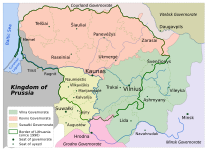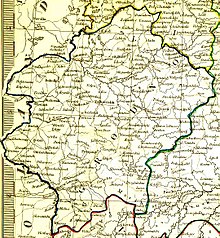| Grodno Governorate Гродненская губерния | |
|---|---|
| Governorate | |
 Coat of arms Coat of arms | |
 Location in the Russian Empire Location in the Russian Empire | |
| Country | Russian Empire |
| Krai | Northwestern |
| Established | 1801 |
| Abolished | 1918 |
| Capital | Grodno |
| Area | |
| • Total | 38,671.5 km (14,931.1 sq mi) |
| Population | |
| • Total | 1,631,645 |
| • Density | 42/km (110/sq mi) |
| • Urban | 15.60% |
| • Rural | 84.40% |




Grodno Governorate was an administrative-territorial unit (guberniya) of the Northwestern Krai of the Russian Empire, with its capital in Grodno. It encompassed 38,671.5 square kilometres (14,931.1 sq mi) in area and consisted of a population of 1,631,645 inhabitants by 1897. Grodno Governorate was bordered by Suwałki Governorate to the north, Vilna Governorate to the northeast, Minsk Governorate to the east, Volhynia Governorate to the south, Kholm Governorate to the west, and Łomża Governorate to the northwest. The governorate covered the areas of modern-day Grodno Region of Belarus, part of the Podlaskie Voivodeship of Poland, and a small part of Druskininkai, Lazdijai and Varėna districts of Lithuania.
Overview
Grodno, a western province or governorate of the former Russian Empire, currently located in Belarus, was situated between about 52° to 54° N latitude and 21° to 24° E longitude, and bounded N by Vilna E by Minsk S by Volhynia and W by the former kingdom of Poland. Its land size was 14,961 square miles (38,750 km). The province was a wide plain in parts, very swampy and covered with large pine tree forests. Of these, that of Białowieża in the district of comprising a circuit of over 100 miles (160 km) deserves notice. There, bisons were preserved. The navigable rivers are Niemen, Bug, Narev, and Bobra, the most important of those being the Bug. The soil is chiefly alluvial intermixed with sand waws, which was favorable for agriculture anil, rearing of cattle and bees. The atmosphere was damp, misty and the climate in winter was cold. Large quantities of rye, barley, oats, hops, hemp and flax were raised but the amount of fruit and vegetables grown was small. The products produced in the region were insignificant, but included woolen cloths, hats, leather, paper and spirits. There also a good export trade in grain, wool, cattle. Some forty fairs were held annually in the province.
It was divided into nine districts:
The administration of the whole province was in the governor appointed by the crown. In 1870 the population was 1,008,521 comprising Lithuanians, Poles, Belarusians, Tartars, and a few German colonists. Grodno's capital was Grodno, on the right bank of the Niemen, and was connected by railway with Moscow and Warsaw. It contained eight Roman Catholic, one Eastern and two United Greek Catholic churches, a chapel, and two Jewish synagogues. There were two fine erected respectively by Stephen Batory who died here 1586 and Augustus III (kings of Poland). Among other buildings were a public library, a school of a gymnasium, and several seminaries. The 24,789 were engaged in the manufacture of woolen hats, paper, and the preparation of wax. Three fairs were held annually.
Grodno was built in the 12th century until 1795 belonged to the Grand Duchy of Lithuania. The diet held there in 1793 ratified the partition of Poland. Two years later Stanislaus, the last king, signed his abdication there.
| Language | People |
|---|---|
| Ruthenians | 470,000 |
| Yiddish | 120,000 |
| Lithuanian | 100,000 |
| Polish | 80,000 |
| Russians | 20,000 |
| Tatars | 10,000 |
| Total | 800,000 |
| Religion | People |
|---|---|
| Roman Catholic | 380,000 |
| Eastern Catholic | 270,000 |
| Judaism | 120,000 |
| Old Believers | 20,000 |
| Muslims | 10,000 |
| Total | 800,000 |
Administrative divisions
The seat was in Grodno. It divided into 9 Uyezds:
- Grodnensky Uyezd (Russian: Гродно)
- Belostoksky Uyezd (Russian: Белосток)
- Belsky Uyezd (Russian: Бельскъ)
- Brestsky Uyezd (Russian: Брестъ-Литовскiй)
- Kobrinsky Uyezd (Russian: Кобринъ)
- Pruzhansky Uyezd (Russian: Пружаны)
- Sokolsky Uyezd (Russian: Соколька)
- Slonimsky Uyezd (Russian: Cлонимъ)
- Volkovyssky Uyezd (Russian: Волкавывскъ)
History
Slonim Governorate (1795–1796)
The governorate was formed in 1796, in the aftermath of the final partition of Polish-Lithuanian Commonwealth, and originally known as Slonim Governorate, but that only existed until December 12, 1796, when Paul I merged it with Vilna Governorate to form Lithuania Governorate.
The Slonim Governorate had 8 provinces:
- Brest (Russian: Волковысского)
- Volkovysskij (Russian: Виленского)
- Grodno (Russian: Завилейского)
- Kobrin (Russian: Кобринского)
- Lida (Russian: Ли́да)
- Novogrudok (Russian: Новогрудского)
- Pruzhany (Russian: Пружанского)
- Slonimsky (Russian: Слонимского)
Lithuania Governorate (1796–1801)
Main article: Lithuania GovernorateJust a year later, on December 12, 1796, by order of Tsar Paul I they were merged into one governorate, called the Lithuanian Governorate, with its capital in Vilnius.
Lithuania-Grodno Governorate (1801–1840)
After Paul's death, by order of Tsar Alexander I on September 9, 1801, the Lithuanian Governorate was split into the Lithuania-Vilnius Governorate and the Lithuania-Grodno Governorate. The Lithuania-Grodno Governorate was restored within the borders of 1796 Slonim Governorate.
The Lithuania-Grodno Governorate had 8 provinces:
- Brest (Russian: Волковысского)
- Volkovysskij (Russian: Виленского)
- Grodno (Russian: Завилейского)
- Kobrin (Russian: Кобринского)
- Lida (Russian: Ли́да)
- Novogrudok (Russian: Новогрудского)
- Pruzhany (Russian: Пружанского)
- Slonimsky (Russian: Слонимского)
- Sokolka Province (Russian: Соколька)
Grodno Governorate (1840–1870)
In 1840 the word "Lithuania" was dropped from the name by Nicholas I.
In 1843, another administrative reform took place. The Vilnius Governorate received the Lida district from the Grodno Governorate and the Belostok Oblast was incorporated into it as the districts of Belostok, Belsk and Sokolka. Also, Novogrudok one to Minsk Governorate
The Grodno Governorate had 9 provinces:
- Brest (Russian: Волковысского)
- Volkovysskij (Russian: Виленского)
- Grodno (Russian: Завилейского)
- Kobrin (Russian: Кобринского)
- Pruzhany (Russian: Пружанского)
- Slonimsky (Russian: Слонимского)
- Belostok Province (Russian: Белосток)
- Belsk Province (Russian: Бельскъ)
- Sokolka Province (Russian: Соколька)
Bialystok-Grodno District (1915–1917)
Main article: Bialystok-Grodno DistrictThe Grodno Governorate was occupied by Germany in 1915 during World War I. It was known as the Bialystok-Grodno District of Ober-Ost. After the Peace of Riga on 18 March 1921, which ended the Polish-Soviet War, the governorate became the voivodeships of Białystok, Nowogródek and Polesie of the Second Polish Republic.
Governors
- General Maurice de Lacy of Grodno (died 1820)
- Mikhail Nikolayevich Muravyov-Vilensky (1830–1831)
Notes
-
- Russian: Гродненская губерния, pre-1918: Гродненская губернія, romanized: Grodnenskaya guberniya
- Belarusian: Гродзенская губерня, romanized: Hrodzienskaya gubernia
- Polish: Gubernia grodzieńska
- Lithuanian: Gardino gubernija
External links
- The new Werner twentieth century edition of the Encyclopædia Britannica. Akron, OH: The Werner Company. 1907. pp. Vol 11, p 183.
- Jeografia wschodniéy części Europy czyli Opis krajów przez wielorakie narody słowiańskie zamieszkanych : obejmujący Prussy, Xsięztwo Poznańskie, Szląsk Pruski, Gallicyą, Rzeczpospolitę Krakowską, Krolestwo Polskie i Litwę, p.214
- Jeografia wschodniéy części Europy czyli Opis krajów przez wielorakie narody słowiańskie zamieszkanych : obejmujący Prussy, Xsięztwo Poznańskie, Szląsk Pruski, Gallicyą, Rzeczpospolitę Krakowską, Krolestwo Polskie i Litwę, p.206
- ^ "Administrative division of Belarus: a historical information" (in Russian). Archived from the original on 2006-10-26. Retrieved 2009-12-30.
- Kulakauskas, Antanas (2002). "Administracinės reformos". Gimtoji istorija. Nuo 7 iki 12 klasės (in Lithuanian). Vilnius: Elektroninės leidybos namai. ISBN 9986-9216-9-4. Archived from the original on 2007-07-17. Retrieved 2008-01-01.
- "Литовская губерния". Brockhaus and Efron Encyclopedic Dictionary (in Russian). 1890–1906.
- Simas Sužiedėlis, ed. (1970–1978). "Administration". Encyclopedia Lituanica. Vol. I. Boston, Massachusetts: Juozas Kapočius. pp. 17–21. LCCN 74-114275.
- K. Marek. Identity and Continuity of States in Public International Law. Librairie Droz 1968. pp. 419-420.
- Eberhardt, Piotr; Jan Owsinski (2003). Ethnic Groups and Population Changes in Twentieth-Century Central-Eastern Europe: History, Data, Analysis. M.E. Sharpe. p. 260. ISBN 0-7656-0665-8.
| Northwestern Krai | |
|---|---|
| Southwestern Krai | |
53°40′00″N 23°49′00″E / 53.6667°N 23.8167°E / 53.6667; 23.8167
Categories: